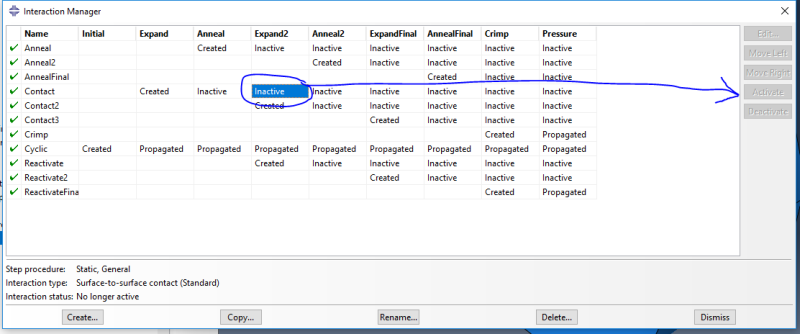I've made a whole lot of progress this past week on my stent analysis. I have it effectively going through a three-step expansion/annealing procedure before a crimp - but now the best I can do is about 61% of the way through the crimp step. Abaqus standard procedure. I think that I'm seeing some type of instability issues, but all I've managed to do is increase from 31% to 61% before failure - but alas it still fails and I've run out of ideas.
I have nlgeom turned on, as well as automatic stabilization and adaptive stabilization (using defaults for both - playing around with the numbers didn't help mush at all that I was able to find at least).
I tried altering solution controls Io and Ir to 8 an 10 respectively, but this job is waiting in line. I'm not incredibly hopeful on these variables though.
I also tried replacing the crimp static step with an implicit quasi-static step. This also required me changing some symmetry in my model. My job is currently waiting in line to run this one so I hope my new definitions are correct and the dynamic can help.
Last thought for now: could I be having problems due to working "outside" the material model? At 61%, I'm showing 21% strain which is exceptionally high. At 53% I'm only at 7.6%, so it's clear the last two steps are somehow messed up. My material model doesn't account for going this high, but my attempts to date with trying to include plasticity in the nitinol model haven't been successful. Despite defining (or believing I'm defining) the material correctly per the UMAT instructions, the material seems to act as though the second half of the model (plasticity data points) aren't there.
Any other thoughts? I have my cae file attached in-case anyone is really curious.
I have nlgeom turned on, as well as automatic stabilization and adaptive stabilization (using defaults for both - playing around with the numbers didn't help mush at all that I was able to find at least).
I tried altering solution controls Io and Ir to 8 an 10 respectively, but this job is waiting in line. I'm not incredibly hopeful on these variables though.
I also tried replacing the crimp static step with an implicit quasi-static step. This also required me changing some symmetry in my model. My job is currently waiting in line to run this one so I hope my new definitions are correct and the dynamic can help.
Last thought for now: could I be having problems due to working "outside" the material model? At 61%, I'm showing 21% strain which is exceptionally high. At 53% I'm only at 7.6%, so it's clear the last two steps are somehow messed up. My material model doesn't account for going this high, but my attempts to date with trying to include plasticity in the nitinol model haven't been successful. Despite defining (or believing I'm defining) the material correctly per the UMAT instructions, the material seems to act as though the second half of the model (plasticity data points) aren't there.
Any other thoughts? I have my cae file attached in-case anyone is really curious.

